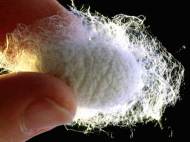Insect silk research could lead to improved fiber production
 A combined team of researchers from the Oxford University and University of Sheffield used a novel method to analyze the energy used in the formation of fibers in natural silk and synthetic materials in order to demonstrate that natural unspun silks taken from a silkworm are a thousand times more efficient than common plastics when it comes to forming fibers.
A combined team of researchers from the Oxford University and University of Sheffield used a novel method to analyze the energy used in the formation of fibers in natural silk and synthetic materials in order to demonstrate that natural unspun silks taken from a silkworm are a thousand times more efficient than common plastics when it comes to forming fibers.
Researchers from the University of Sheffield developed a method called shear-induced polarized light imaging (SIPLI) to look at changes in the makeup of materials. They used polarized light shining through a disk rotating over a plate to study how fibers are formed as the two materials are spun.
In collaboration with researchers from Oxford University, they measured how much energy was needed to initiate the formation of fibers from the Chinese silkworm (Bombyx mori) and molten high density polyethylene (HDPE) – a material used to make hollow goods manufactured through blow molding (such as milk bottles), wood plastic composites, and even ballistic plates.
Dr Chris Holland said: “Combining the best of polymer science with biology we were able to determine how much energy is required to form these two fibers. And it seems that we have discovered some fundamental differences between natural and synthetic materials. With hundreds of millions of years of R&D in fiber production it is not surprising that silkworms and spiders have found ways to conserve energy while still making superior fibers”, said Dr Chris Holland, member of the Oxford Silk Group at the Oxford University’s Department of Zoology.
In order to form filaments, HDPE has to be heated over 125°C (257°F) and requires substantial energy of shear force to mold the material once in its molten form. On the other hand, natural silk is able to form filaments at ambient temperature and it requires ten times less shear force to be molded.
“This is in stark contrast to oil-based high performance fibers that require high temperatures and create harmful waste”, said Dr Oleksandr Mykhaylyk from the Department of Chemistry at the University of Sheffield. “Whilst these high performance and green credentials of silks are well known, the spider and silkworm can now add one more to the list, energy costs. This is about being inspired by nature to discover and implement things that can help mankind to weather the upcoming storms on our quality of life.”
The results of the tests revealed that the production of fibers from the synthetic material was dependent the amount of spinning, while the silk material was dependent on the speed of the spinning. During the stretching process, natural silk loses water. According to researchers, that process allows the material to ‘lock in’ its fiber formation in a form of a ratchet without the need to be cooled as plastics do.
For more information, read the article published in the journal Advanced Materials named: “Silk and Synthetic Polymers: Reconciling 100 Degrees of Separation”.









Researchers should increase their attention at these projects since we could benefit in less energy consumption and stronger materials.
“The results of the tests revealed that the production of fibers from the synthetic material was dependent the amount of spinning, while the silk material was dependent on the speed of the spinning.”
Makes sense due to viscosity and different temperatures involved.
I have one remark thou, this is a scientific website and you should use Kelvin instead Celsius and Fahrenheit when you refer to temperatures.
author
I understand you point Michael, however, it is easier to relate to commonly used units of measurement without the need to convert those from K.
Good case of biomimicry.
Dr.A.Jagadeesh Nellore(AP),India
E-mail: anumakonda.jagadeesh@gmail.com